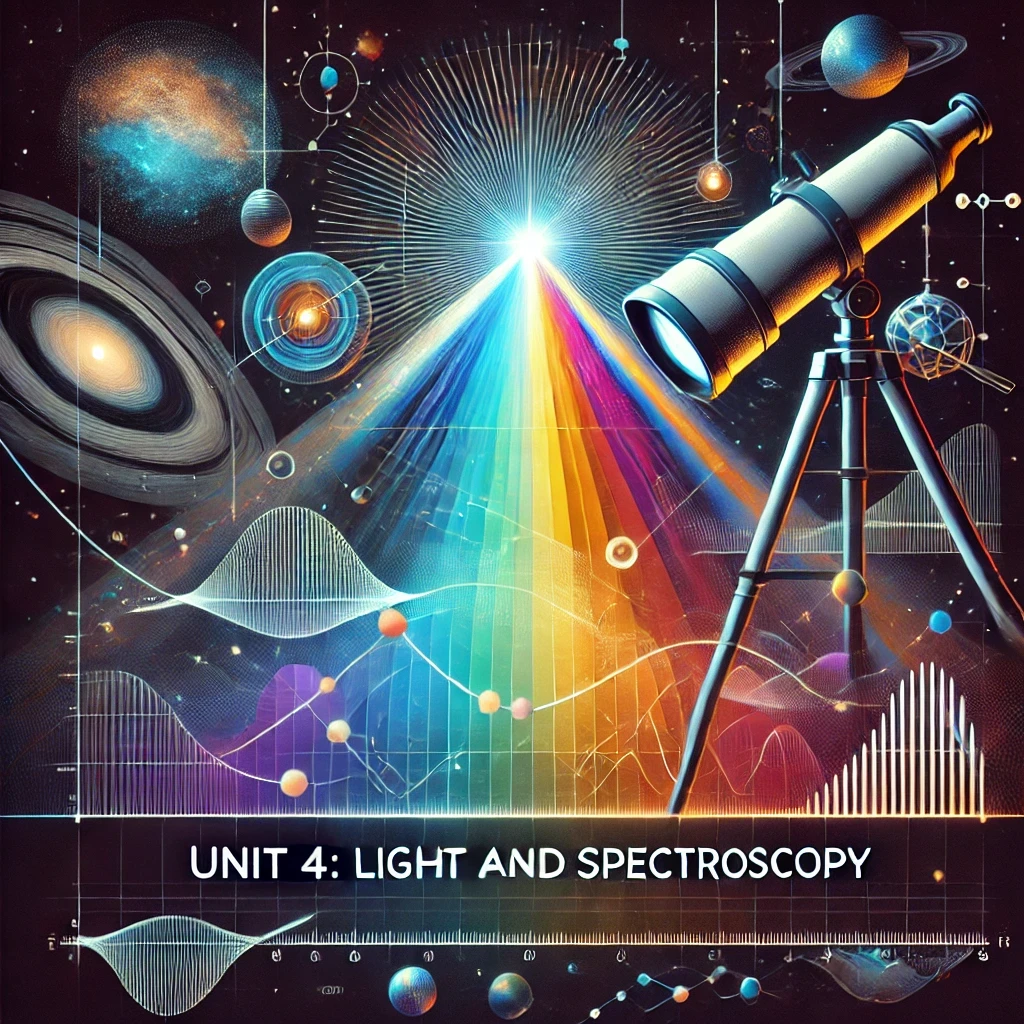Spectroscopy is a crucial tool in astronomy, enabling us to decode the light from stars, galaxies, and distant worlds to uncover their secrets. In this unit, you’ll explore the nature of light, from the electromagnetic spectrum to wave-particle duality. Discover how blackbody radiation reveals the temperatures of celestial objects, how atomic energies produce the spectral lines that serve as cosmic fingerprints, and how spectroscopy helps astronomers determine the composition, temperature, and motion of objects across the universe.

Teacher Assessment
- Summary Notes
- Assignment/Project
Self-Assessment
- Each section of this unit includes a set of “Check Your Understanding” questions that are designed to prepare you for the midterm exam.
-
4.1 The Nature of Light
- Electromagnetic Waves: Introduction to the electromagnetic spectrum, including types of electromagnetic radiation from radio waves to gamma rays and their significance in astronomy.
- Wave Properties: Exploration of key properties of light such as amplitude, wavelength, and frequency, with a detailed explanation of the relationship between wavelength and frequency through the wave equation.
- Wave-Particle Duality: Discussion of light’s dual nature as both a wave and a particle (photons) and how photon energy is calculated using Planck’s equation.
- Interaction of Light with Matter: Detailed coverage of how light interacts with matter through reflection, refraction, and absorption, and their applications in telescope design and astronomical observations.
- Applications in Astronomy: The use of different wavelengths across the electromagnetic spectrum to study celestial phenomena, including radio waves, infrared, ultraviolet, and X-rays.
4.2 Blackbody Radiation
- Blackbody Spectrum: Examination of the radiation emitted by blackbodies and how it varies with temperature.
- Wien’s Displacement Law: Explanation of how temperature relates to the peak wavelength of blackbody radiation, revealing the color-temperature relationship of stars.
- Stefan-Boltzmann Law: Discussion on how the total energy radiated by a blackbody per unit area depends on its temperature, helping to explain the luminosity of stars.
- Color Indices and Stellar Classification: Overview of how color indices are used to classify stars by temperature and color, with references to the Hertzsprung-Russell diagram.
4.3 Atomic Energies
- Quantum Nature of Light: Review of light’s wave-particle duality and the concept of photon energy using Planck’s equation.
- Electron Volts: Introduction to electron volts (eV) as a unit of energy, with practical conversion examples relevant to atomic physics.
- Bohr Model and Atomic Energy Levels: Explanation of the quantized energy levels in atoms and the transitions between these levels that give rise to emission and absorption spectra.
- Hydrogen Spectrum: Detailed exploration of the Lyman, Balmer, and Paschen series in hydrogen and their importance in astronomical spectroscopy.
- Ionization Energy: The role of ionization energy in determining the conditions within stars and other celestial bodies.
4.4 Spectroscopy I: Principles of Spectroscopy
- Types of Spectra: Introduction to continuous, emission, and absorption spectra, with a focus on how they are produced under different astrophysical conditions.
- Kirchhoff’s Laws of Spectroscopy: An explanation of Kirchhoff’s three laws that govern the production of spectra and their applications in astronomy.
- Spectral Line Broadening: Examination of broadening mechanisms such as Doppler broadening and their astrophysical significance in understanding stellar and galactic motions.
4.5 Spectroscopy II: Applications of Spectroscopy
- Identifying Elements in Stars: How the analysis of absorption and emission lines in spectra is used to identify the chemical composition of stars and other celestial objects.
- Measuring Stellar Velocities: Detailed discussion on the Doppler effect and its role in measuring the radial velocities of stars and galaxies, with applications to detecting exoplanets and studying stellar motion.
- Practical Spectroscopic Analysis: Overview of spectral line catalogs, databases, and tools astronomers use to analyze stellar spectra and determine the physical properties of celestial objects.
Assignment: Spectroscopy in Action
- Print off the attached assignment.
- Follow the steps and complete the questions.
- Submit your document with the questions answered.
Course Resources
- Free Textbook: Astronomy by OpenStax.
- AI Tutor: Astronomy Tutor to support you with this class.
Science Curricular Connections
Physics 11:
- Properties and behaviors of waves
- Generation and propagation of waves
Physics 12:
- Electromagnetic induction and its applications
- Doppler effect
Chemistry 11:
- Quantum mechanical model and electron configuration
- Analysis techniques (e.g., spectroscopy)
Chemistry 12:
- Energy change during a chemical reaction
Earth Sciences 11:
- Solar radiation interactions
Learning Standards
- I can describe the electromagnetic spectrum, including the types of electromagnetic radiation and their importance in astronomy.
- I can explain wave-particle duality and calculate the energy of photons using Planck’s equation.
- I can describe the principles of blackbody radiation and explain how it relates to the temperature and energy output of stars.
- I can apply Wien’s Displacement Law to determine the peak wavelength of radiation and the Stefan-Boltzmann Law to calculate the total energy radiated by stars.
- I can explain the structure of atoms and how the interaction of electromagnetic radiation with electrons produces emission and absorption spectra.
- I can distinguish between continuous, absorption, and emission spectra, and describe the conditions under which each is produced.
- I can apply Kirchhoff’s laws of spectroscopy to explain the formation of continuous, emission, and absorption spectra in various astrophysical environments.
- I can explain the mechanisms of spectral line broadening, including Doppler broadening, and understand their significance in the study of stellar and galactic motions.
- I can use spectroscopy to identify the chemical composition, temperature, and other properties of stars and celestial objects.
- I can explain the Doppler effect and apply it to measure the radial velocities of stars and galaxies.
- I can describe how line lists, spectral catalogs, and practical spectroscopy tools are used to analyze the composition and motion of celestial bodies.